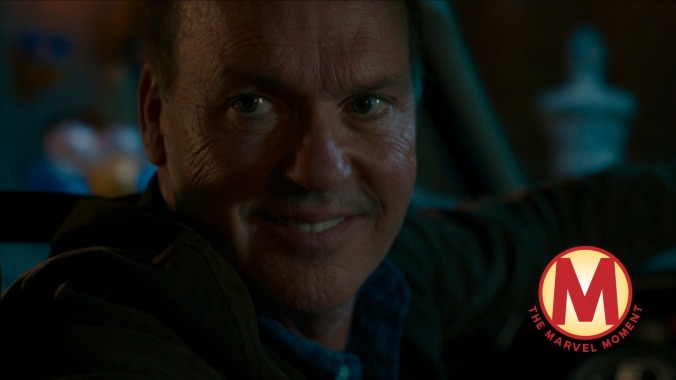Marvel makes room for some great acting during an awkward parental car ride


Is there anything more intrinsically Peter Parker than being trapped in the back seat of a supervillain’s car—but only because he’s actually his ride? Spider-Man: Homecoming spends large swaths of its running time watching Tom Holland’s Peter juggle his day-to-day life against his wider franchise obligations (sorry, “commitments to the superhero community”), which involves a whole bunch of explosions, alien super-weapons, and largely non-memorable aerial acrobatics. (Also: A lot more of Jon Favreau’s Happy Hogan than anyone could ever possibly have been clamoring for.) So it’s telling that the film’s most memorable confrontation deploys no special effect flashier than a sickly green light washing over Michael Keaton’s craggy face, smirking mirthlessly as he drives his daughter and her recently outed-as-a-pain-in-the-ass-superhero date to the big school dance.
As with many of the antagonists who popped up in Marvel’s Phase Three efforts, Keaton’s Vulture feels like a deliberate attempt to push back against the MCU’s harshest critics and the recurring “villain problem” they’d frequently called out—i.e., the thing where most of the universe’s non-Loki antagonists are boring as hell, wasting good actors in forgettable, makeup-slathered parts. By bringing him way closer to the Parker doorstep than Peter had any hope of predicting, Homecoming doesn’t just position Adrian Toomes in the fine tradition of friends’ dads who want Spider-Man dead. It also lets Keaton be terrifying as a man, rather than as a suit of CGI armor, riffing on the classic “dad talk” with world-weariness in his voice and a loaded pistol in his hand. Keaton’s Toomes sounds absolutely sincere when he talks about his love for his daughter. He sounds equally so when expressing his willingness to murder Peter and everyone he loves if he ever crosses him again.
For films that skew resolutely youthful in their target demographics, the MCU movies feature a real dearth of characters who aren’t at least pushing 30 as they punch their way across the stars. By making Pete’s big confrontation with its villain a dark riff on the old, familiar anxiety of being awkwardly trapped in a social situation with your significant other’s parents, Homecoming positions itself as the lone teen movie in a universe full of grouchy, aging dudes. Tom Holland nails the million or so emotions flooding through Peter’s brain in this moment, most notably a deep, palpable fear that few superhero characters are typically allowed to express. (His willingness to be totally vulnerable in moments like this is a key part of how Holland’s Spidey so quickly became the emotional linchpin of the entire MCU.) And as Liz, Laura Harrier heightens the menace step by step, if only by treating her father as just another regular dad; she’s totally oblivious to the blood on his hands.
But it’s Keaton’s scene, obviously: He casually underplays the most violent of threats, even as the manic energy that powered so many “You wanna get nuts?” flares up in tiny little sparks. The inclusion of these kinds of small, memorable acting showcases has always been a key part of what makes the MCU far more than just the sum of its frequently lackluster action sequences. Even the worst of these films—and Homecoming is far from the worst, even if it could do with one less run of “But what would Mr. Stark do?!” whining—has some sort of moment like this, a place where a member of one of the most phenomenal casts of actors ever assembled for a big-budget cinematic project can really cut loose. Like Spidey himself, these movies wrestle constantly with their place in a larger, less forgiving world. And like Spidey, they occasionally manage to do exactly the right thing, just in the nick of time.
GET A.V.CLUB RIGHT IN YOUR INBOX
Pop culture obsessives writing for the pop culture obsessed.